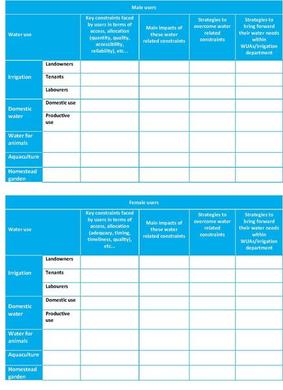Tool 15
TOOL 15. IDENTIFICATION OF WATER ACCESS CONSTRAINTS
To identify water access constraints among different groups of users.
OBJECTIVE
To identify water access constraints among different groups of users.
METHOD
Focus group discussions with different user groups (separated by sex and water use service)
Step 1: Draw up a matrix
Explain the exercise to focus group participants and draw up a matrix of 4 columns and 8 rows (more can be added when needed). See Table 11 for an example. Include the water use services identified from the MASSMUS exercise in the left column. Note down the number of participants, the user group they represent and the sex of the participants.
Step 2: List water-related constraints
Ask the participants to list the constraints they face related to water in terms of access, allocation (physical access, adequacy, timing, timeliness, quality), and other. Write these in the second column, using symbols where possible.
Step 3: Impacts
Using the matrix, discuss the following with the group participants.
- What are main impacts of these water constraints?
- What do people do to overcome these water-related constraints?
- How do people ensure their water needs and interests are brought forward within WUAs and the irrigation department?
Write the answers on the flipchart.
Table 11 - Water-related constraints

Source: Wiegers and Wahaj, n.d
BASED ON
Tool 2 in: Wiegers, E., and Wahaj R., forthcoming.Multiple Uses of Water Services for Men and Women in Large Irrigation Systems: Engendering the MASSMUS approach, MASSMUS Gender Module, Rome: Food and Agriculture Organization of the United Nations.
